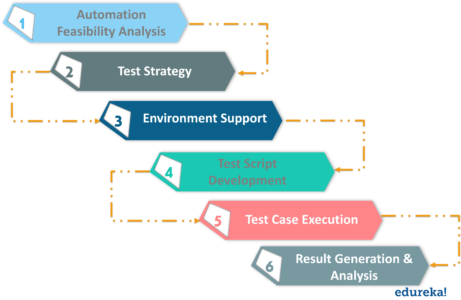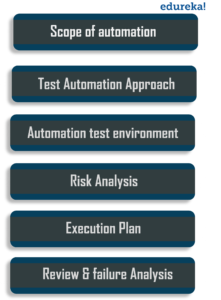Selenium Course
- 65k Enrolled Learners
- Weekend/Weekday
- Live Class
Software testing has become a critical and ever growing part of the development life-cycle. Initially, it relied on large teams executing manual test cases. This has changed in recent years as testing teams have found a way to facilitate a faster deployment cycle: test automation. A cost-effective automation testing strategy with a result-oriented approach is always a key to success in automation testing. In this article let’s see how to build a good test automation strategy.
In manual testing, testing of a web application is done manually, by human action. Someone actually goes on a device to evaluate numerous components including design, functionality, and performance. But, manual testing can be mundane, error-prone, time-consuming, often repetitive and even boring. Whereas automation testing uses the assistance of tools, scripts, and software to perform test cases on various levels of the software.
Some of the advantages of test automation over manual testing are as follows:
This blog is almost an introduction to Automation, if you want to dive deeper in automation strategies, you can visit the Automation testing training course by Edureka.
One of the most common mistakes with test automation is going for the immediate benefits and forgetting about the bigger picture. Many teams abandon their automation efforts after a sprint or two and go back to manual testing. Now, why do you think that happens?
Most of the time, most of these companies use automation just because others are using it. Here are some of the problems:
So, what they need here to succeed in test automation is careful planning and strategy: Test Automation Strategy. You can get a better understanding with the Best software testing course.
A cost-effective test automation strategy with a result-oriented approach is always a key to success in automation testing. Having a good test automation strategy will help businesses keep pace with the market and avoid any major technology failures.
To build a good test automation strategy you need to be familiar with test automation life cycle. Let’s explore the same:
Automation test life cycle has the following phases

In this step, you check the feasibility of automation. This includes shortlisting the relevant test cases for automation and selecting the right test tool that fits your requirement.
Related Learning: Types of Automation Testing
Here, you select the test automation framework. You have multiple options to choose from here. For example, linear test automation framework, data-driven framework, key-word driven framework etc.
In this phase, you set up the testing environment and acquire the required hardware and software to execute the automated test cases.
In this step, you start creating the automation test scripts. Make sure that the scripts that you have written are reusable, well-structured and well documented.
In this step, you execute the test cases that you have written previously.
In this last phase of test automation life cycle, you analyze the output of test cases and share the reports with stakeholders.
The prime objective of any software project is to get a high-quality output while reducing the cost and the time required for completing the project. A good test automation strategy helps companies achieve that. Below is the list of building blocks of automation test strategy:

Defining a project scope includes outlining timelines and milestones for each sprint in the project. Two most important things here are:
One of the best models that can help you with that task is Mike Cohn’s “Test Automation Pyramid”. According to the pyramid, unit tests are quick to write. They have the highest ROI(Return of Investment) and should ideally form the backbone of your automation testing strategy. Regression test should be your next priority. Next, you need to check functionality and other quality characteristics with functional testing. Then comes UI(User Interface) tests. They are expensive, require heavy maintenance, and return the highest number of false positives/negatives.
You need to select one out of the several test automation tools available in the market. That can be a difficult task. In order to select the tool that fits best for your project, first, you need to understand your project requirements thoroughly. Identify your budget. Select the tools that fit your requirement and within your budget. Then you can shortlist based on other parameters such as licensing cost of the tool, maintenance cost, training and support, tools extensibility, performance and stability
Setting up your test environment is another building block of test automation strategy. You can establish your automation test environment
Test automation is like a deterministic game, where, known inputs will produce predictable outputs. A stable and predictable test environment is a prerequisite for successful test automation.
Find out our Automation Testing Training in Top Cities/Countries
| India | Other Cities/Countries |
| Bangalore | UK |
| Hyderabad | USA |
| Pune | Canada |
| Chennai | Singapore |
When choosing a test automation approach, there are three areas to consider: Processes, Technology, and Roles
Your automation roll out must always be a well-defined and structural process.
Here you figure out everything about the applications that you want to automate. Figure out which technology they are based on and whether your test automation platform supports these technologies.
The job roles for the test automation team are defined here. You need to make sure that all members know who is responsible for which part of the automation project. Every member of a test team, may it be domain specialists, technical testers, and test management play an important role in making test automation work. You should adopt a test automation platform that all testers can work with easily so that automation becomes a natural part of the daily work of all team members.
As we know risk analysis is an essential part of project planning in general, but it is important to consider it in the test automation as well. By considering a few viable parameters you can create a risk document. The parameters would be something like:
One important thing here is that the risk document is dynamic. Risks will be added and removed to the list as the project evolves.
A test automation strategy should also define the process of execution and management of test cases. Text execution should outline things like day-to-day tasks and procedures related to automation. Consider the below suggestions when executing test cases:
Related Learning: Automation Testing Interview Questions
Having a plan for how to analyze the failed test cases and resolve them is a critical part of test automation strategy. Often time is taken to notify the failure, analyze it and resolve it much longer than you anticipate. Having a well-defined process for this can save a lot of time and effort for the development team. Outline how different errors should be handled. These errors can be:
Next, all the things that you have done till now, including the methods that you adopted to implement automation, test results, pros and cons of the test automation strategy should be captured and documented for future reference. Then you continuously improve your test automation strategy by learning from the mistakes. Revamp your test automation strategy.
So, these are some important steps and requirements that you can follow to build a cost-effective and empowered test automation strategy.
A successful testing strategy and framework can positively impact your business and organization in a number of ways like:
A successful testing strategy can lead to big things! It’s very much necessary to come up with an intelligent test automation strategy to fully enjoy the benefits of automation testing and achieve the desired level of success. Hope the things that you have learned here today will help you as you head out on your automation journey.
If you find yourself more interested in Selenium, you can visit Selenium Course by Edureka.
Got a question for us? Please mention it in the comments section of this ‘Test Automation Strategy’ article and we will get back to you.
 Thank you for registering Join Edureka Meetup community for 100+ Free Webinars each month JOIN MEETUP GROUP
Thank you for registering Join Edureka Meetup community for 100+ Free Webinars each month JOIN MEETUP GROUPedureka.co
Great post. Thanks for sharing the information.